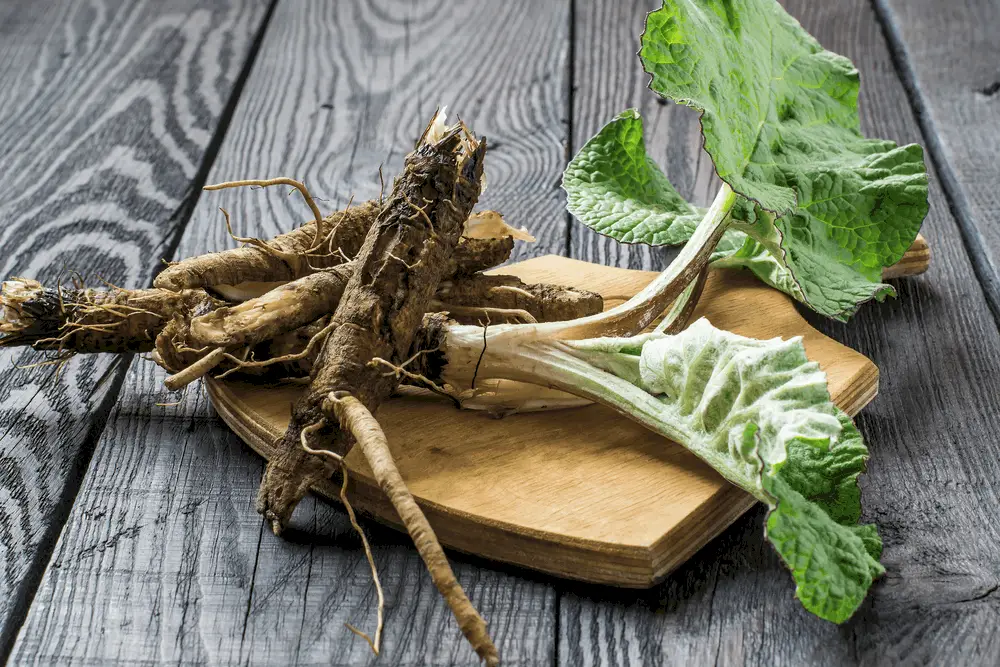Burdock root for eczema, is it effective? Burdock derives from various places all around the world. It has been utilized for many decades as a food source and treatment for a broad range of conditions. The plant contains properties that combat bacteria and germs, decrease fever, and purifies the blood. It also has anti-inflammatory properties, which makes it an ideal treatment for eczema, acne, psoriasis, and other skin conditions.
Does burdock root for eczema work? While research is limited, the medical community believes that burdock root is an effective eczema treatment. There are several ways to utilize the burdock root when treating eczema and other skin conditions. It can be consumed orally or applied directly to the affected areas.
What Parts Of The Plant Are Utilized For Medicine?
Like most plants that are utilized to make medicine, only specific parts of the burdock plant contain medicinal properties. These parts include the seed, leaf, and root. All these components are combined with other ingredients to combat eczema, bladder infections, joint pain, hypertension (high blood pressure), and gout.
Burdock Root Cream: Home Remedy Recipe
To prepare burdock root as a topical medicine, it is crucial to break it down into tiny particles. You can do this by utilizing a mortar and pestle or rotary grater (can be substituted for a cheese grater). Most of the root should be soft, so crushing it with a mortar and pestle should be easy. If you encounter any hard parts, you can crush it with the grater.
The next step is to utilize the burdock root to create a cream. Some herbalists suggest adding the burdock root particles to a sensitive skin moisturizer. But, if you prefer making a skin cream from scratch, you can combine the burdock root to oatmeal and lemon juice. To create a cream from scratch, you will need to mix about ¼ teaspoon of the burdock root with 1 tablespoon of lemon juice and 1/8 cup of dry oatmeal. The correct consistency will be a thick paste. If necessary, you can add a few drops of sterile water to achieve the right consistency.
It is recommended to apply the burdock root cream to the affected areas at least twice a day. Leave in place for about 15 minutes and rinse with water.
Oral Or Topical
Burdock root can also be consumed orally. However, when it comes to treating skin conditions, such as eczema and psoriasis, the maximum results can be achieved faster when applied directly to the skin. Herbalists recommend taking burdock root orally when treating high blood pressure, obesity, constipation, and bladder infections.
Chlorogenic Acid
Burdock root is rich in chlorogenic acid, a polyphenol, antimicrobial, and antioxidant. Chlorogenic acid is believed to be an effective treatment for hypertension, diabetes, and atherosclerosis. While the amount of chlorogenic acid found in burdock root is not as high as that of coffee, when combined with other properties found in the root, it makes the perfect treatment for eczema.
As an antimicrobial, chlorogenic acid is effective in eradicating microorganisms, such as viruses, bacteria, fungi, and protozoans. As an antioxidant, chlorogenic acid has the ability to inhibit oxidation, a chemical reaction that generates free radicals, cancer-causing agents. As a phytochemical, chlorogenic acid keeps plants healthy and in humans, it can reduce the risk of conditions, such as cancer and heart disease.
Inflammatory Properties
Burdock root has anti-inflammatory properties that are believed to decrease redness, pain, edema (swelling), and itching, all the symptoms associated with eczema. Burdock root is a powerful anti-inflammatory when it is utilized as a topical medicine. When taken orally, it is still capable of combating inflammation, but the results may not be as effective. So, burdock root for eczema is highly recommended by herbalist around the globe.
Antibacterial Properties
While eczema is not a dangerous condition, if left untreated it can be very uncomfortable. A secondary condition associated with untreated eczema is skin infections. People who pick or scratch their eczema are at a higher risk of skin infections compared to those who properly treat their condition.
Burdock root has antibacterial properties, making it an ideal treatment for eczema. While the burdock root is combating the inflammation associated with the condition, it is also fighting infection. A study published in the Journal of Microbiology and Biotechnology in March 2017, revealed that burdock root may be an effective treatment for pneumonia and persistent K infections.
Detoxifying Agents
Burdock root is believed to contain detoxifying agents. Detoxifying the body has shown to be very beneficial. The benefits offered by burdock detoxification include weight loss, more energy, stronger immune system, and healthier skin.
For people with eczema, burdock detoxification can play a big role in keeping the skin healthy. It can also help reduce eczema flare-ups. Detoxification helps to rid the body of harmful waste products and heavy metals.
A common burdock root detoxifying homemade recipe consists of dandelion root, burdock root, and ginger root. Combine two parts of each ingredient into a quart glass jar with a ½ cup of 100 proof vodka. It will take about four weeks for the ingredients to macerate. Once it is done, you will be able to utilize it to detox your liver.
Anti-Aging Properties
Burdock root also contains anti-aging properties. These properties can slow down the aging process. When utilized as a topical medicine, burdock root can reduce wrinkles, especially those found around the outer corner of the eye, a condition known as crow’s feet.
To achieve the maximum results of burdock root, you need to be consistent. Apply a few dots of the cream along the orbital bone and gently massage it in with your ring finger, avoiding the eyes. You should repeat this treatment two to three times a day.
It’s important to note that burdock root is not a miracle cure for wrinkles. But, when utilized appropriately and consistently, improvement will be noticeable within the first few days of treatment.
Other Uses
While the evidence is still insufficient, it is believed that burdock root can treat a broad range of other conditions. These conditions include anorexia, fever, crow’s feet, wrinkles, diabetes, breast cancer, stomach ailments, and gout.
Burdock Root: Benefits
Burdock root offers a broad range of health and weight loss benefits. Again, the evidence is limited but herbalists believe the herb can fight cancer, inflammation, and infection. It is also believed to boost skin health, promote a healthy weight, regulate blood glucose and blood pressure levels, and boost immunity.
It is not recommended to take burdock root without speaking to a medical professional first. If you are currently taking medications for diabetes, a blood disorder, or heart disease, you should not take burdock root. The herb should also not be taken up to a week before surgery or dental procedures.
Burdock Root: Side Effects
Herbalists believe that burdock root is generally safe for human consumption. However, consuming large amounts of the root can be lethal. It’s recommended to not consume more than the amount normally found in food. When utilized as a topical medicine, burdock root treatment should not surpass four weeks. Until more evidence is available, medical experts are not certain what is a safe dosage.
Burdock Root: Contraindications
People with bleeding disorders, such as Hemophilia A, Factor II, and Von Willebrand’s disease, should not take burdock root. It is believed that burdock root may slow blood clotting. In most cases, blood disorders develop when an individual’s blood cannot form a clot or plug at the sight of an injured or damaged blood vessel.
Burdock root should not be consumed prior to surgery. If you are scheduled to undergo dental treatment, an invasive out-patient procedure, or surgery, you should stop taking burdock root at least a week prior to your appointment. Speak with your physician, surgeon, or dentist about utilizing burdock root to avoid bleeding problems.
Summary
Burdock root for eczema works effectively. However, to achieve maximum results, it is recommended to utilize it as a topical medicine. Apply directly to the skin, leave in place for at least 15 minutes, and rinse thoroughly. Repeat this treatment two to three times a day but no longer than four weeks. The root, seed, and leaf of the burdock plant contain the medicinal properties needed to treat eczema, acne, psoriasis, and rosacea.
Related Questions
Do you peel burdock root?
It is not truly necessary to peel the burdock root. Some people do peel it when utilizing it in soups and stir fry. If you are going to utilize it to make a topical or oral concoction, you do not need to peel it. However, it will need to be grated down to small particles to achieve the maximum benefits.
How do you store burdock root?
There are several ways to store the burdock root. It can be stored in a refrigerator for up to seven days. For longer storage, you will need to clean, boil, place in a freezer bag, and store it in a freezer. It will last for up to six months when stored in a freezer.
Recent Posts
Eczema vs Bed Bug Bites: How to Tell the Difference? (W/ Pictures)
Trying to figure out the difference between eczema vs. bed bug bites? If your skin is covered in itchy red welts or splotches, your first thought might be that you are dealing with eczema. It is,...
Best Sunscreen for Babies With Eczema: Top 13 Picks (Updated 2020)
With summer always on the verge, it’s never too early to start looking for the best sunscreen for babies with eczema. Oh yes, even though winter is on the rise at the time of this article...

